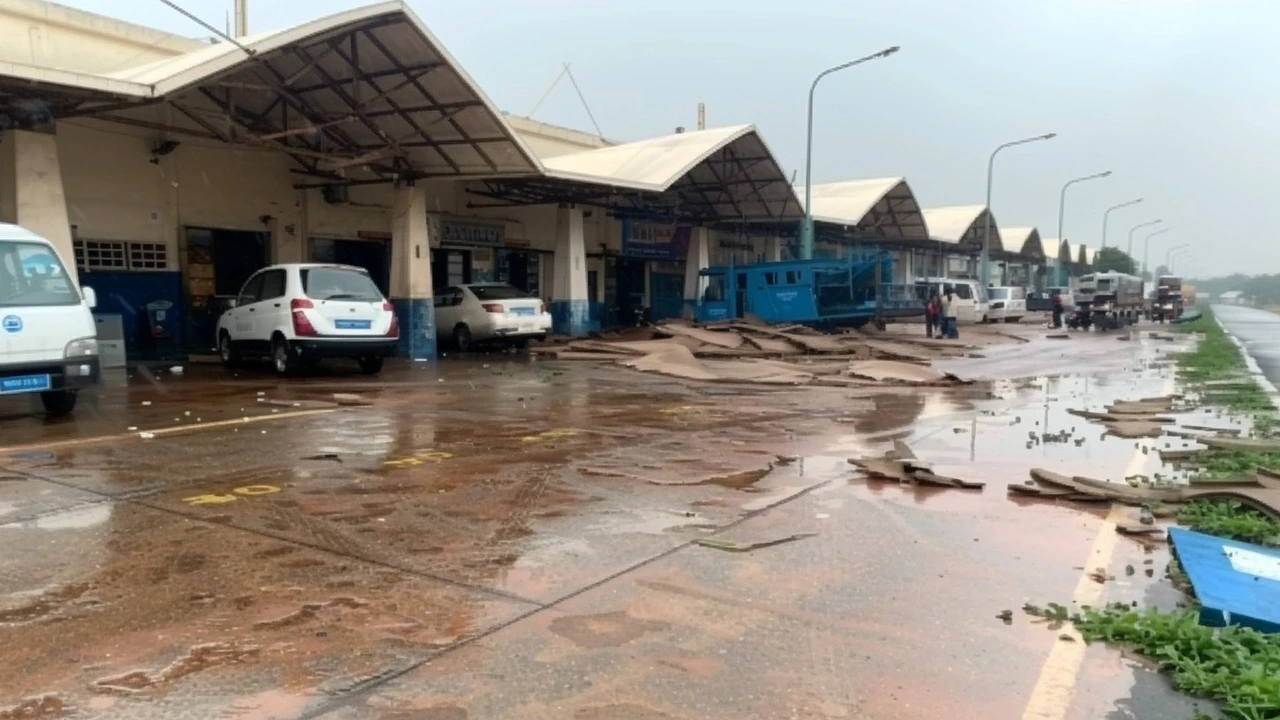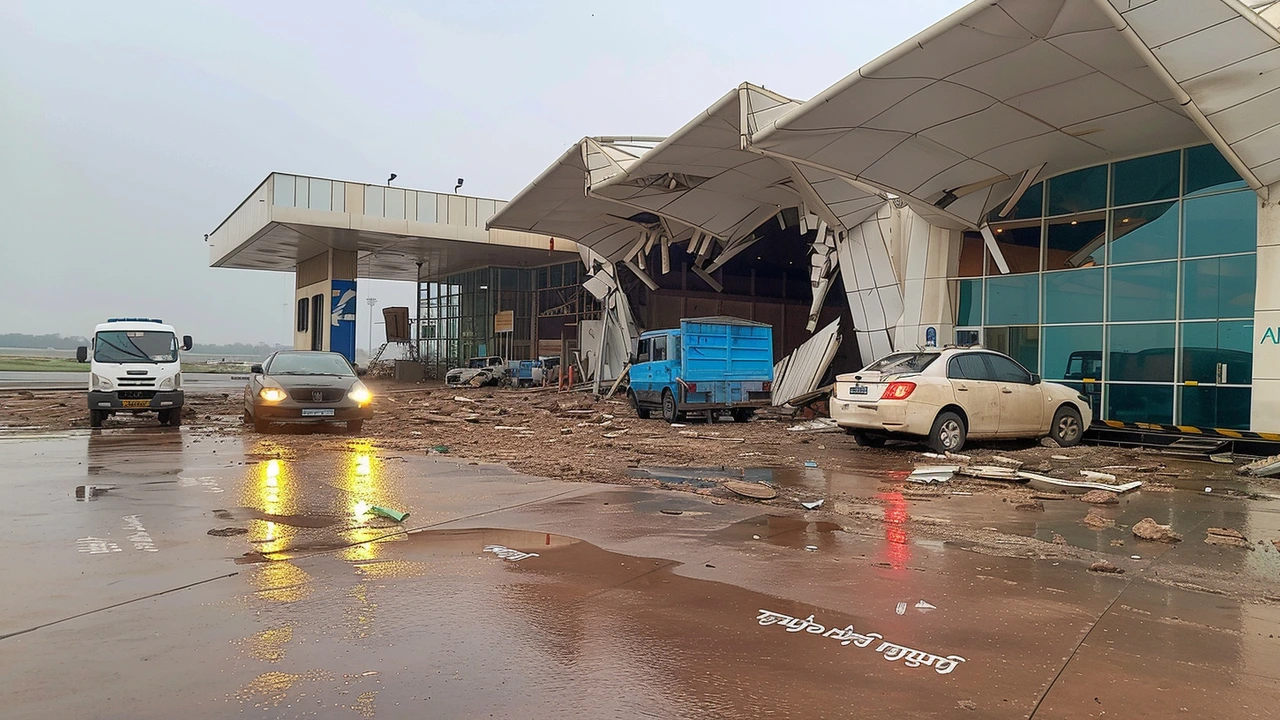
Rajkot Airport Canopy Collapse Sparks Safety Concerns
The recent collapse of a canopy at the Rajkot airport terminal in Gujarat, India, has sent ripples of concern through the aviation industry and government authorities alike. The incident, which occurred on Saturday, June 29, 2024, during a bout of heavy rainfall, fortunately did not result in any injuries. However, it has raised critical questions about the structural integrity and maintenance standards of airport facilities across the country.
This canopy collapse at Rajkot airport came on the heels of a tragic event at New Delhi's Indira Gandhi International (IGI) Airport just a day prior, when the roof at Terminal-1 gave way, killing one person and injuring eight others on Friday, June 28, 2024. These events are part of a disturbing pattern; another canopy had similarly failed at Dumna airport on Thursday, June 27, 2024. In the span of just three days, three major airports in India have faced serious structural failures amidst adverse weather conditions.
Inauguration and Aftermath
What makes the Rajkot incident particularly shocking is that the airport was inaugurated by Prime Minister Narendra Modi less than a year ago, in July 2023. With such a short time lapse between its opening and this structural failure, questions are being raised about the quality of construction and oversight during the airport's development. The collapse occurred in the passenger pickup and drop-off area, a high-traffic spot that could easily have seen casualties under slightly different circumstances.
As of now, flight operations from the affected areas of these airports have been suspended as authorities carry out investigations. The Civil Aviation Minister, Ram Mohan Naidu Kinjarapu, has wasted no time in ordering a thorough preliminary structural inspection across all airports in the country. He has sought detailed reports from each airport within a short span of 2-5 days, emphasizing the urgency and gravity of the situation.

Immediate Response and Long-Term Measures
Minister Kinjarapu's directive is aimed at preventing further incidents and ensuring passenger safety. The ministry is expected to take several measures based on the findings of these inspections. This could include increased funding for maintenance, stricter adherence to safety protocols, and perhaps even revisions in the design standards for airport constructions to withstand extreme weather conditions.
The authorities have acted swiftly in issuing a circular to airlines, instructing them not to hike fares amidst the disruption. This measure is designed to prevent passenger exploitation in light of the ongoing travel inconveniences. While the primary focus remains on safety and investigation, ensuring that air travel remains accessible is also a key concern for the ministry.
Broader Implications for Public Infrastructure
These incidents are not just isolated events but could be indicative of broader systemic issues affecting public infrastructure in India. Heavy rains are a common occurrence, and with the increasing impact of climate change, infrastructures need to be more resilient. Airport authorities and government officials will need to collaborate closely to address these deficiencies, prioritizing both immediate repairs and long-term sustainability.
The general public, meanwhile, remains understandably anxious. Airports are typically considered to be among the safest public spaces, with significant resources allocated for their construction and maintenance. The recent collapses have shaken this trust, making reforms in public infrastructure safety more pressing than ever.

Moving Forward: Ensuring Safety and Trust
The coming weeks will be crucial as the government and aviation authorities navigate the aftermath of these structural failures. Public communication will play a critical role in rebuilding trust. Ensuring transparency in the inspection processes, promptly addressing detected deficiencies, and implementing robust safety measures will be essential. Investments in technology for better monitoring and quick response systems during emergencies can also be expected to take center stage.
In summary, the incidents at Rajkot, Dumna, and New Delhi airports are a wake-up call for all stakeholders involved in the design, construction, and maintenance of public infrastructures. As investigations proceed and remedial measures are put in place, the priority remains clear: ensuring that such distressing events do not repeat, thus guaranteeing the safety and security of passengers and providing peace of mind to the public.
6 Comments
Sara Lohmaier June 30, 2024 AT 21:24
lol so now even airports are falling apart? guess we should've expected this after seeing how fast the roads crack after one monsoon. they probably used cardboard beams under that canopy. 🤦♂️
Sara Lohmaier July 2, 2024 AT 18:39
The structural failures at Rajkot, Dumna, and IGI are deeply concerning and reflect a systemic lapse in quality assurance protocols. It is imperative that independent third-party engineering audits be mandated for all public infrastructure projects, especially those commissioned under high-profile inaugurations. Safety cannot be sacrificed for political optics or accelerated timelines.
Sara Lohmaier July 3, 2024 AT 21:55
This is heartbreaking. I fly out of Rajkot often - that canopy was right over the drop-off where my mom waits for me. One second too late and she’d have been under it. We’ve been begging for repairs since last year but nothing happened. The government needs to stop treating infrastructure like a photo op and start treating it like a lifeline.
Sara Lohmaier July 5, 2024 AT 18:04
The minister's swift response is commendable, but let’s not mistake urgency for sustainability. A 2-5 day inspection window is unrealistic for comprehensive structural analysis. What’s needed is a national infrastructure resilience fund, with transparent public dashboards showing inspection results, repair timelines, and contractor performance histories. Accountability isn’t a buzzword - it’s the foundation of public trust.
Sara Lohmaier July 6, 2024 AT 23:37
Imagine if this happened at a Walmart. The lawsuits would bankrupt the company. But nope - it’s a government project. So we get a press release, a photo of a minister holding a clipboard, and then silence. This isn’t negligence. This is institutionalized contempt for human life wrapped in a flag.
Sara Lohmaier July 8, 2024 AT 20:57
We build monuments to progress while ignoring the foundations. Airports are supposed to be temples of modernity - safe, reliable, awe-inspiring. Instead, we get structures that collapse like sandcastles under a summer shower. And yet, we keep celebrating the ribbon-cutting, not the stress tests. Maybe the real tragedy isn’t the collapse - it’s that we’ve stopped being shocked when it happens. We’ve normalized decay. We’ve turned infrastructure into performance art for politicians and a punchline for the rest of us.